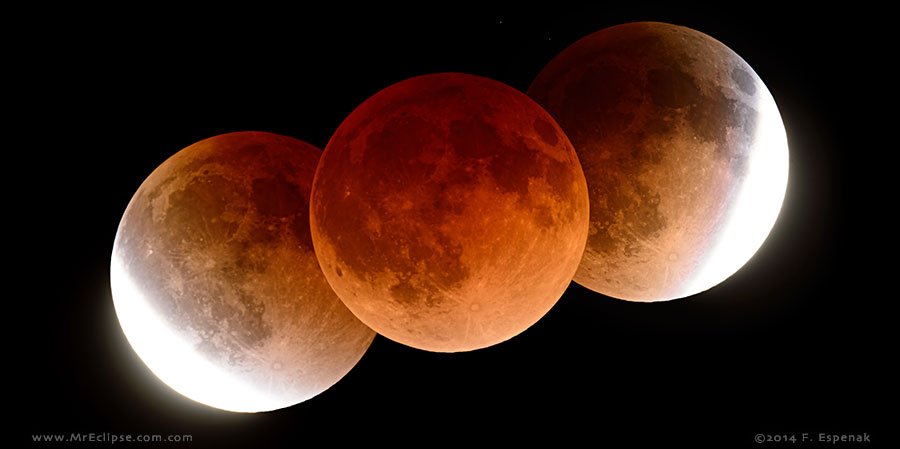 A total eclipse of the Moon occurs during the night of September 27-28, 2015. Observers throughout the Americas and Europe will have a front row seat as the Moon slowly glides though Earth’s shadow.
A total eclipse of the Moon occurs during the night of September 27-28, 2015. Observers throughout the Americas and Europe will have a front row seat as the Moon slowly glides though Earth’s shadow.
The eclipse will be seen in its entirety from eastern North America, South America, the Atlantic Ocean, western Europe and western Africa. From western North America, early eclipse phases occur before moonrise. Similarly, observers in Eastern Europe, the Middle East and East Africa will experience moonset during some phase of the eclipse. None of the eclipse is visible from eastern Asia, Japan, Australia or New Zealand.
During a total lunar eclipse, the Moon’s disk can take on a dramatically colorful appearance from bright orange to blood red and more rarely dark brown to very dark gray. One of the wonderful things about lunar eclipses is that they are completely safe to view with the naked eye. No special filters are required to protect your eyes like those used for solar eclipses. You don’t need a telescope to watch the eclipse, although a good pair of binoculars will enhance your experience.
An eclipse of the Moon can only take place at Full Moon, and only if the Moon passes through some portion of Earth’s shadow. The shadow is actually composed of two cone-shaped parts, one nested inside the other. The outer shadow or penumbra is a zone where Earth blocks some (but not all) of the Sun’s rays. In contrast, the inner shadow or umbra is a region where Earth blocks all direct sunlight from reaching the Moon.
During a total eclipse, the Moon passes completely inside Earth’s umbral shadow. If only part of the Moon passes through the umbra, a partial lunar eclipse is seen. It is also possible to have an eclipse where the Moon only passes through the penumbra. Each of these three eclipses types has a unique appearance.
A Supermoon is a full Moon or a new Moon at its closest point to Earth; also called perigee. A Supermoon looks around 12 to 14% bigger than its counterpart, the Micromoon.

The Moon will be totally eclipsed for more than 3 hours.
When a full Moon or new Moon coincides with being closest to Earth, it is called a Supermoon, Super Full Moon, or Super New Moon.

A Micromoon, on the other hand, is when a full or a new Moon is farthest from the Earth (apogee). It’s also sometimes known as a Minimoon, Mini Full Moon or a Mini New Moon.
“Supermoon| Not an Official Name.
Supermoon is not an official astronomical term. It was first coined by an astrologer, Richard Nolle, in 1979. He defined it as ‘a new or a full Moon that occurs when the Moon is at or near (within 90% of) its closest approach to Earth in its orbit’. It is not clear why he chose the 90% cut off in his definition.
There are currently no official rules as to how close or far the Moon must be to qualify as a Supermoon or a Micro Moon. Different outlets use different definitions. Due to this, a full Moon classified as a Supermoon by one source may not qualify as a Super Full Moon by another.
Supermoon Definition
- Supermoon: A full or new Moon that occurs when the Moon is less than 360,000 kilometers (ca. 223,694 miles) from the center of the Earth.
- Micromoon: A full Moon or new Moon that takes place when the Moon is farther than 400,000 kilometers (ca. 248,548 miles) from the Earth.
Technical Name: Perigee-syzygy
The technical term for a supermoon is perigee-syzygy of the Earth-Moon-Sun system. In astronomy, the term syzygy refers to the straight-line configuration of three celestial bodies.
When the Moon is close to the lunar nodes of its path during syzygy, it causes a Total Solar Eclipse or a Total Lunar Eclipse
September 27/28: Total Lunar Eclipse
Looks Bigger and Brighter

Because it’s co close to Earth, a Super Full Moon looks about 7% bigger than an average full Moon. When compared to a Micromoon, it looks about 12-14% larger.
A Super Full Moon also looks about 30% brighter than a Micro Full Moon and about 16% brighter than an average full Moon.
Full Moons that occur before and after a Super Full Moon tend to also look bigger and brighter than an average full Moon. These full Moons are also often called Supermoons by many sources.
(c)timeanddate; eclipsewise



























You must be logged in to post a comment.